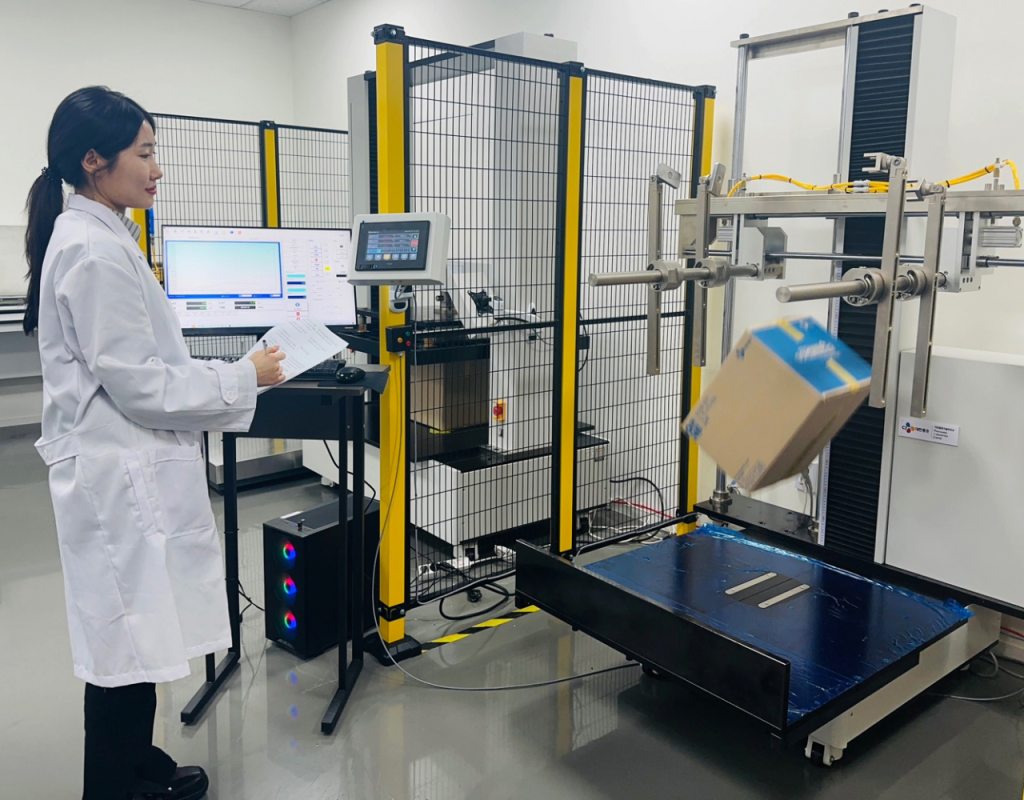Rigorous testing, careful R&D at Packaging Innovation Center (PIC) ensure durable boxes that hold up under all conditions

On April 11, CJ Logistics announced the launch of a new system to handle clothing. The Apparel Automated Packaging System (APPS), which incorporates CJ Logistics’ award-winning packaging solutions, is just one of many advances that the company’s Packaging Innovation Center (PIC) has achieved.
Researchers at the center prioritize customer satisfaction by carefully testing delivery boxes for durability. They also work consistently to commercialize next-generation packaging technologies.
Garments moving through the APPS are automatically arranged in a single line on a fabric surface and wrapped as they move. This reduces logistics costs and maximizes efficiency. The APPS also features recycled plastic packaging and an easy-cut process that eliminates the need for scissors. The One-Touch Box and Invoice Type Tape make it possible to wrap the box without using tape. These accomplishments earned CJ Logistics the top prize in the e-commerce category at the World Packaging Organization’s 2024 World Star Packaging Awards.
Durability Tests at the Packaging Innovation Center
The PIC, located in the Hwaseong Dongtan Logistics Complex near Seoul, Korea, houses various testing facilities that ensure the safety and durability of all CJ Logistics delivery boxes. The company’s packaging undergoes extensive tests at the safety laboratory. In the logistics environment testing laboratory, boxes are tested further. There’s also an automation equipment verification room and a sample production room.
The center’s mandate is to reduce the risk of damage during transportation in the most cost-effective way possible. Researchers at the center ensure that the company’s packaging protects its contents even under harsh weather, transportation and warehouse conditions. Some of the tests they conduct include the box compression test, the drop test, the vibration test and the temperature test.
The box compression test establishes how much weight a delivery box can support if it ends up at the bottom of a heavy stack of boxes. To pass, all CJ Logistics delivery boxes must be able to bear loads of up to 5,000 kilograms.
In a drop test, boxes are dropped approximately 470 times from heights of up to 1.2 meters to assess their durability and identify any weak points such as edges and corners.
In a vibration test, delivery boxes are subjected to approximately 60,000 vibrations from different angles. All packages must be fit to travel long distances whether the terrain is smooth and even or hilly and rough.
Temperature tests measure how well the contents of a box fare in temperatures ranging from minus 25 degrees Celsius to plus 40 degrees Celsius.
Enhancing Consumer Convenience, Lowering Logistics Costs and Attracting High-Tech Clients
CJ Logistics aims to introduce product-specific packaging later this year, part of an initiative to heighten customer satisfaction by optimizing packaging for faster, more secure deliveries. By using the center’s test data to tailor its packaging to individual products, the company aims to minimize costs for client companies while reducing the risk of damage to items.
The center’s reputation for reliable packaging has led to inquiries from smartphone and semiconductor manufacturers. This is a pivotal step for CJ Logistics, which intends to diversify its clientele to include a higher proportion of high-tech industries.
“To drive innovation in logistics, particularly in packaging, it’s crucial to grasp market dynamics and customer needs,” said Kim Chan-woo, head of the packaging technology team at CJ Logistics. “That’s the only way to address challenges. Drawing on the insights we’ve gained from customer interactions and the center’s test data, we’re tailoring our packaging solutions and optimizing them for specific delivery needs.”
CJ Logistics is strategically positioning itself within the next-generation packaging market, in close alignment with the global logistics industry’s focus on sustainability and the need to optimize packaging for enhanced cost-effectiveness. Notably, industry leader DHL anticipates a remarkable 79.9% growth trajectory for the next-generation packaging segment over the coming decade. Projections indicate a substantial market expansion — from 30.92 billion USD (36.9 trillion KRW) in 2021 to 55.63 billion USD (66.4 trillion KRW) by 2032.











